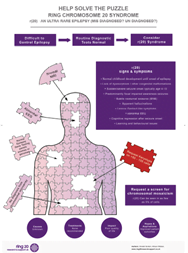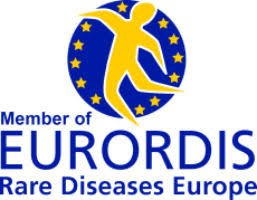Signs and Symptoms of r(20) syndrome
We ask that you please consider chromosomal analysis if you have a patient with the following symptoms:
- In most of the cases normal childhood development until onset of epilepsy
- Predominantly focal impaired awareness seizures
- Medically refractory epilepsy with long lasting focal seizures with impaired awareness with normal neuroimaging
- Frequent nocturnal seizures (in most of the cases subtle and of frontal lobe origin)
- Interictal EEG with characteristic appearance with log trains of theta waves, with a peak at 5 Hz and a sharply contoured or notchy appearance
- Epilepsy (often onset between 4 and 11 yrs), may be associated with cognitive difficulties (epileptic encephalopathy) and with non convulsive status epilepticus
- Lack of dysmorphism or other congenital malformations
- Cognitive impairment/learning difficulties very often after the onset of epilepsy
- Behaviour disorder

Why diagnosing r(20) syndrome matters
There are many reasons why patients have seizures, both genetic and non-genetic. Finding the cause is enormously helpful to physicians to guide treatment, identify other clinical problems that patients may be at risk for, and provide prognostic information. Finding the cause is therefore helpful to patients, both for the reasons just mentioned, and because it provides an explanation for their child’s problems. Because the ring chromosome 20 syndrome is diagnosed by chromosome analysis, which is not routinely done for all patients with seizures, we believe that this disorder is likely under-diagnosed. Considering r(20) as a potential source of the resulting symptoms and getting appropriate testing could help families solve the diagnostic odyssey and ensure appropriate treatment plans are in place

What to do if you suspect r(20) syndrome
If you suspect r(20) syndrome, cytogenetic (chromosome) confirmation of the diagnosis is essential.
Since chromosomal analysis or karyotype testing is not a routine investigation when epilepsy first presents, the diagnosis of r(20) syndrome may be delayed or go unrecognized.
Please note:
- We have seen the ring 20 in as few as 5% of cells, and we recommend requesting a screen for chromosomal mosaicism. Since r(20) syndrome can present as a mosaic with the ring in only a small number of cells, a minimum of 50 cells must be analyzed.
- Newer array technology (CGH or SNP arrays) will NOT detect the ring chromosome and we recommend standard metaphase chromosome analysis.
Appropriate Diagnostic Testing Procedure for r(20) syndrome
Ring 20 is usually diagnosed by cytogenetic (chromosome) analysis from a small blood sample. The Chromosomes from the cells in the blood are examined and the ring is usually obvious under a microscope. The diagnosis can also be made from skin cells.
Newer DNA tests such as sequencing will miss rings. Chromosomal microarray testing will identify deletions that may occur when the ring is formed, but this is only true in 1/3 of Ring 20 patients. For a diagnosis, it remains necessary to look at Chromosomes through a microscope to see their shape. However, additional molecular genetic tests such as FISH and microarrays from the same blood sample will show more precisely where the ends of the chromosome have broken and how much chromosome material, if any, is missing. The ring 20 may also be analysed from skin cells, but this is rare because obtaining a skin biopsy for the test is more invasive and most physicians and patients prefer to obtain a blood sample








